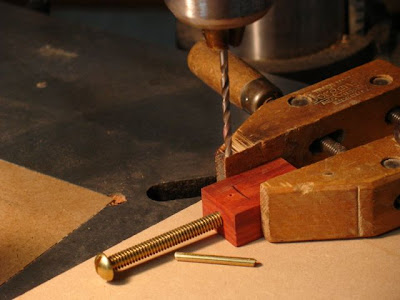 |
| Is This the One? |
I really don't want to fall into that "The Best -----" genre of story titles but couldn't resist. You know what I mean at the check out counters i.e. Best Way to Lose Weight; Best 10K Time Training Program; Best $5.00 Wine on the Market; Best Dovetails Ever; and so it goes. I always suspect those titles because really, how many Best Ways can there be to do the same thing?
I can't take full credit for this method of making a zero clearance plate because it's something I saw years ago in a magazine and filed it away into the recesses of my mind hoping it would surface at just the right time. Well, after using the dial indicator to set up my tablesaw that time has arrived. Now that it's over I'm really glad I went through this process. Making the adjustments to the saw changed the location of the blade in reference to the throat plate so it was no longer a zero clearance set up.
Like many of you, I've gone through the stage of using the factory plate on the saw, then making my own from plywood, and finally buying a specialized one made of phenolic and complete with adjusters and everything! I'm Dutch and these things aren't inexpensive so I still was left with the factory plate for my rip blade and shop made plates for various sized dados. The concept behind this plate was to use the same specialized plate for everything but make inserts customized to any blade configuration needed. Here's where I started this process.
The first step was to create a channel on top of the plate to accept the inserts. I'm using 1/4" MDF so cut a bunch of strips about 1 3/4" wide. These strips should be 8"-10" longer than the throat plate, that's not a critical measurement though; just use what you have. To cut the channel I used a 1/2" straight bit in the router and made successive passes to achieve the needed depth. At the same time, make a sample piece or two with the identical cuts in a piece of scrap material, I used MDF for that. You'll need that to fine tune the width of the channel.
 |
| Router Table Set Up |
I gradually increased the depth of the channel until the MDF fit. It's ever so slightly proud but that will be easy enough to fine tune with a piece of sandpaper.
 |
| Checking Depth |
Once the channel is complete I changed over to a 14 degree dovetail bit. Here's where that piece with the trial channel cut into it comes in play. Use it to fine tune the depth needed.
 |
| Setting Depth |
Once that's dialed in you'll cut both sides of the channel to create a dovetailed slot for the insert to slide into. The next step requires small adjustments with the fence to get a good fit. Your strips should be longer than needed so you'll have plenty of pieces to experiment with. The first step is to cut a 14 degree angle on one side of each strip. Now comes the fine tuning.
 |
| Are We There Yet? |
The beveled edge on the strip will want to slide underneath your fence so it's best to clamp a piece of plywood to your fence, push it down tightly to the table. I'm using a clamp close to the cutter to keep the strip down so the 14 degree bevel is consistent the entire length of the strip. Now it's a matter of gradually cutting the piece down until it slides into the channel with just a bit of resistance.
Each strip will need a hole drilled into it so you can remove the plate from the tablesaw. Mine happened to be 3/4" so slide the strip into the channel, leave it proud and drill the hole completely through all of them.
 |
| Finger Holes |
By this time I was pretty tired of all the machine noise and dust so went traditional for the last couple of steps. Insert the strip and line up the finger hole. Clamp that into your vise and use a coping saw to make it fit.
 |
| Final Shaping |
Sure, you could use a guided bearing in your router but this works too. I also cut a pass down the area in the back where the splitter goes then used a chisel to pop that piece out.
 |
| Not Pretty but Works! |
 |
| It's a Beautiful Thing! |
Now I have about 8 of these strips ready to go for any blade I need to put on the tablesaw. As they get sloppy I can just toss it and install a fresh one. Make sure that when you're making your initial cut into the strip that you put your fence over it to hold it down. For a dado blade I'd recommend that you clamp a piece of MDF over the entire insert when making that initial cut.
Let me know if you decide to try this for your own saw, I'd be curious to hear your opinions!












































